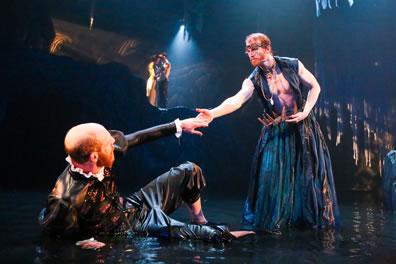The Tempest
Shakespeare and Shamu Meet in a Tempest
Synetic Theater, Arlington, Va.
Wednesday, February 27, 2013, D-112&113 (center front orchestra, splash zone)
Directed by Paata Tsikurishvili

Prospero (Philip Fletcher) offers forgiveness and a hand up to Alonso (Ryan Tumulty) as Prospero's daughter, Miranda (Irina Kavsadze) and Alonso's son Ferdinand )Scott Brown) court in the background in Synetic Theater's watery production of The Tempest. Photo by Johnny Shryock, Synetic Theater.
Note to my old colleague Shamu: How about Shakespeare for your next SeaWorld show? Synetic Theater has one ready-made for you, The Tempest, and it's sure to thrill the whole family.
I know, the name Shakespeare connotes "high-brow" theater for those many park patrons who haven't given him a chance, just like the name Shamu connotes "low-brow" entertainment for many theater elitists who haven't given you a chance. So, what do Shakespeare and Shamu have in common other than the consonant sound at the front of your names?
A splash zone, in the case of Synetic's The Tempest. I've never before attended a Shakespeare play—or any theater, for that matter, other than the theaters where you and your fellow Odontoceti perform at marine theme parks—where I was handed a rain poncho free with my ticket. Plus this Tempest is such an accomplishment in Shakespearean theater, Hamlet himself would consider it very like a whale of a good time.
Aside from the ankle-deep water covering the stage, this Tempest differs from typical versions of the play in that it is wordless. Synetic Theater is a dance and acrobatic mime company that has been successfully staging what it calls Silent Shakespeare for much of the company's 10-year history. The play's poetry is expressed through movement and physical expression set to music.
Heck, Shamu, you could play Ariel, with the way you, a force of nature, leap about and fly through the air, except that Dan Istrate has nailed down that role in Synetic's production. His Ariel was electric—he even looked electric in his hallucinatory costume designed by Anastasia R. Simes: metallic with silver spikes on his collar and cuffs, and a chainmail skirt hanging from his belt. Dancing in the on-stage sea and playing a grand piano with streams of water flowing out of its keyboard, Ariel seemed at risk of becoming "Jove's lightning," but he "flamed amazement" merely through his dancing and miming antics.
Simes' costumes were stunners all around, from Caliban's devil-like red horns and mystical iconography covering his red body to the Renaissance royalty in lace ruffs and shimmering dresses, from Prospero's billowing skirt and midriff-revealing vest to Miranda's gold-trimmed white dress with midriff-revealing straps. In costumes alone, this production will appeal to children (fantastical), women (sexy), and men (sexy). Part of the show's magic, frankly, is how the actors dance in these costumes, especially the gowns and courtier clothes, when they are soaking wet. The actors also have to maintain their characters in mime even as water is constantly splashing in their faces.
Simes also designed the set: Beyond the on-stage sea is a multi-level cliff that doubles as the King of Naples' ship. At one end is a slide that Ariel and his sprites could slide down like otters at play, and at the other end is the gated cave that serves as Caliban's grotto. Lighting Designer Andrew F. Griffin supplements Prospero's wizardry, effectively using lights and highlights for seamless segues from scene to scene, from past to present, and from vision to reality.
Given that this is silent Shakespeare, director Paata Tsikurishvili acts out the backstory that Shakespeare covers in the dialogue. Prospero (Philip Fletcher) arrives on the island with infant in arms. He is attacked by Sycorax (Victoria Bertocci), whom he kills in the fight, as Caliban (Vato Tsikurishvili) watches (a departure from the text, which indicates that Caliban was already orphaned by the time Prospero arrived). Prospero adopts Caliban and frees Ariel from the cliff, and the two spirits become something like brothers. As Miranda (Irina Kavsadze) comes of age, she and Caliban are close playfellows to the point of falling in love. But Caliban wants to act on this love before Miranda is ready, and we see the attempted rape that Prospero stops, leading to Caliban's subsequent imprisonment.
In Vato Tsikurishvili's performance, Caliban comes off as a character we feel sorry for, even though we witness his reprehensible act. He is a simple soul, easily frightened, and hardly able to conceive anything beyond his natural surroundings. The comedy in Tsikurishvili's presentation arises from this trait, but after he is imprisoned we see him look sadly out the cage that his cave has become with the look of a puppy who knows he's in trouble but doesn't know why.
When Prospero tells Miranda the tale of his exile, we get another departure from the original text: Prospero's brother is now his sister, Antonia (Francesca Jandasek). When Naples invades Milan, she holds a knife to the infant Miranda to stop Prospero from fighting. You have to read the synopsis in the program to get this, though; watching the play, Antonia could be taken for Prospero's wife, a really cruel mother who jumps from lover (King Alonso, played by Ryan Tumulty) to lover (Alonso's brother, Sebastian, played by Pasquale Guiducci). In this confusion, Prospero's forgiveness at the end seems entirely uncalled for, even for the most virtuous among us. As it is, Antonia being his sister, Jandasek plays her with such unremitting selfishness and cruelty that we can't help feeling that both Prospero and Miranda better watch their backs; Ferdinand might be the next target of her power-hungry seduction.
Ferdinand (Scott Brown), though, has not won his prize lightly. Rather than carrying logs needlessly, he has as his task to clean the island with bucket and brush. The smitten Miranda soon joins him with her own brush, and the two Synetic veterans do a lovely courtship pas de deux, one of the two highlights in Irina Tsikurishvili's choreography. The other is a comic dance courtesy of Caliban and his co-conspirators, Stephano (Irakli Kavsadze) and Trinculo (here a woman played by Emily Whitworth) when they are distracted by the clothes Prospero and Ariel have hung for them. After Stephano has dressed himself in hairy midriff-revealing women's lingerie, Ariel uses his spell-binding powers to manipulate the conspirators like puppets, and the three perform one done-to-death disco dance after another against their wills, all while wearing puzzled expressions (Whitworth's Trinculo even looks embarrassed).
From a purely Shakespearean perspective, this production comes up short only in what is missing: the wedding vision and Ariel's chaffing at his lack of freedom. The former would have been yet another great opportunity to show off the Synetic wizardry, while the latter may have been simply a matter of interpretation, for Ariel being set free is a moving moment as the spirit literally disappears into thin air when he slides under his piano.
Some additions, however, add interesting substance to the play. When Caliban recounts his story to Stephano and Trinculo, he portrays a loving mother ruthlessly killed without reason by Prospero, not at all the history we've seen. The Tempest can be staged from several perspectives, namely Prospero's, Ariel's, or Caliban's. Paata Tsikurishvili gives us all three. But he also heightens Prospero's moment of redemption to thrilling drama. When he has Alonso, Antonia, and Sebastian suffering fits of insanity through the illusions he manufactures, Prospero revels in his power and the revenge at his fingertips. But he stops and, in a glow of light, realizes he has become as cruel as they. One by one, he makes peace with each, and the alliance instantly forged with Alonso is particularly heartfelt and strong. After the rest board their ship and Ariel has dissipated, Prospero stays behind to discard his glowing staff and his book, which lights up his face when he opens it. He sets the book on the sea, and as it floats across the stage, he departs with the others. Caliban emerges, finds the book, and with its glow now projecting onto his face, he looks out over our heads into his uncertain future, orphaned again, all his companions gone, his powers confined to the fingers with which he can dig up pignuts. Darkness closes in on this lonely being, whose mother and a surrogate father may have taught him much, but neither taught him their magic.
This final image comes after the big production-climax dance by the ensemble, during which Prospero and Ariel combine to create waves of water that, Shamu-like, splash off the stage and into the first four rows of the audience. Some people chose not to wear their free ponchos: They were mistaken. Let's face it, you cannot understate the role of water in this theatrical experience. Director Tsikurishvili in his program notes argues for his decision to stage this play in water on thematic as well as dramatic grounds: "For me, water has all the versatility appropriate to Prospero's story: the potential for hilarious comedy and silliness, combined with sadness, mystery, danger, and, most of all, a quality of literal and figurative reflectiveness."

Dan Istrate as Ariel in the Synetic Theater's production of The Tempest. Anastasia R. Simes designed the costumes that allowed actors to dance and perform acrobatics in water while spectacularly depicting the spirits, the Renaissance Italians, and the marooned inhabitants of the island. Photo by Johnny Shryock, Synetic Theater.
All true, but there's also the singularity of real water splashing on and off the stage in a theater, the same visceral attraction that causes audiences to fill up the clearly marked splash zones at SeaWorld amphitheaters before seats in the rest of the grandstands are occupied. Splashing the crowd has become integral to the shows there, too, bringing out the biggest whale to create the biggest waves.
Even when I was a private audience of one, the big splash was Shamu's ultimate punchline. As a trade journalist for the amusement industry I beta tested a "trainer for a day" program at SeaWorld. Important to note: while I did hands-on work with dolphins and belugas, I did not get in the water with the killer whales—even trainers, skilled and athletic as they are, are not allowed in the tank with the whales until they have apprenticed for more than a year. Ironically, a portion of the day was spent, Ferdinand-like, cleaning the deck, because that's part of being a trainer, too. But I did learn how to give a command that a whale executed for me. Standing outside the tank, the trainer by my side used gestures to transfer command to me, and the whale turned her full attention on me, looking me right in the eye. I gave the motion with my arm, and the whale did her thing, which, of course, ended up causing a tidal wave over the tank, intended to leave me soaked (the trainers only told me half of what I was commanding the whale to do). Even though I was now in on the prank, the trainers got me to do it twice again, as this exercise was part of the whale's daily husbandry, I was good at giving the command, and the trainers wanted to see how much cold water I could take washing over me. But I was eager to do it: That eye-to-eye connection, and the whale seeming to regard me with more familiarity each time, was a deeper sensation than cold seawater soaking my bones.
Thus, for The Tempest at Synetic Theater, you cannot overstate the water, either. This show is Shakespeare wonderful: silent, acrobatic, balletic, and wet, yes, but also poetic, dramatic, magical, and emotional, too.
Eric Minton
March 2, 2013
Comment: e-mail editorial@shakespeareances.com
Start a discussion in the Bardroom



 Find additional Shakespeareances
Find additional Shakespeareances